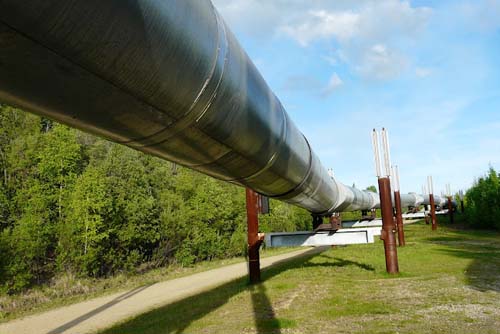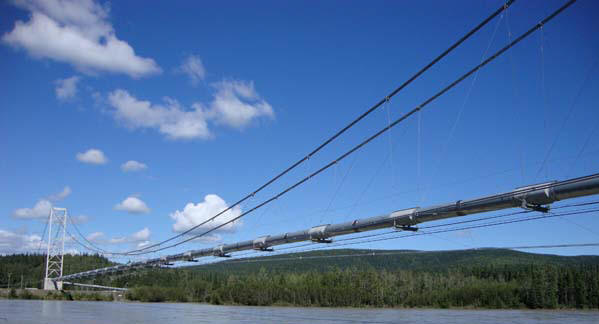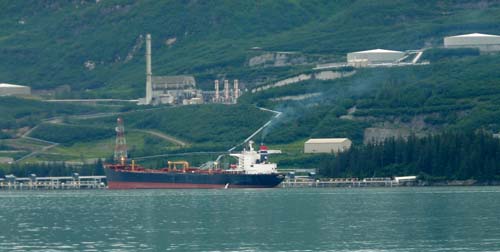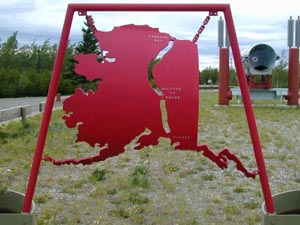
The 800-mile-long, 48-inch-diameter trans- Alaska oil pipeline parallels the Richardson Highway through the Delta Junction area on its way to the Port of Valdez. The line is underground where it crosses the Alaska Highway about half a mile southeast of the center of Delta Junction. At Big Delta, the oil pipeline crosses the Tanana River on a cable suspension bridge. (See the photo below)


Valdez Terminal
Twenty-two Alyeska technicians and supervisors, local residents, work here – 7 days on and 7 days off, 12 hours a day. Also at Pump Station 9 is a Civil Maintenance Contractor crew, totaling 10 people, assigned to oil spill initial response and line maintenance.
A few facts about the three pipelines that have come through Delta in the past. Only one is operating today (Alaska Pipeline).
 Three major pipelines have been built through the Delta area – and a pipe section’ display will be found in front of the Visitors Information Center. The pipeline begins in Prudhoe Bay and ends in Valdez.
Three major pipelines have been built through the Delta area – and a pipe section’ display will be found in front of the Visitors Information Center. The pipeline begins in Prudhoe Bay and ends in Valdez.
The first pipeline was the three-incher built as part of the famous Canol project during World War II. It delivered refined petroleum products from Whitehorse to the emergency airfields on the Canadian side and to Northway, Tanacross, Big Delta, and Ladd Field, now Fort Wainwright, in Alaska. During the September 1942 – September 1945 period, 7,943 aircraft were delivered to the Russian Air Forces under the Lend-Lease program utilizing these airfields. At war’s end, the line fell into disuse, and most the pipe has been salvaged out in recent years.
The second line is the eight-inch Haines pipeline, which was built in 1954 to transport petroleum products from the port of Haines to military installations in Interior Alaska. Parts of this line are still in place and, though the line and its pumping stations [one of which is located about 12 miles north of Delta on the Richardson Highway have been inactivated, the line was used as recently as 1980 when some surplus military fuel was moved out of the Tok area.
 The third is the 48-inch trans Alaska pipeline, which was completed in June of 1977, twenty-seven months after the first length of pipe was laid. This line was built by private contractors working for Alyeska Pipeline Service Company, the agent for the eight major oil companies who own the oil being transported. The total construction cost was over 9.5 billion dollars. The trans Alaska pipeline transports crude oil from the oil fields on Alaska’s North Slope to the Port of Valdez.
The third is the 48-inch trans Alaska pipeline, which was completed in June of 1977, twenty-seven months after the first length of pipe was laid. This line was built by private contractors working for Alyeska Pipeline Service Company, the agent for the eight major oil companies who own the oil being transported. The total construction cost was over 9.5 billion dollars. The trans Alaska pipeline transports crude oil from the oil fields on Alaska’s North Slope to the Port of Valdez.